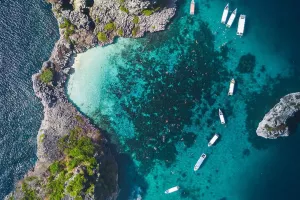Nature has created many unparalleled natural landscapes. As one of the landscapes, the desert is mysterious and beautiful. As we all know, the world is composed of land and ocean.
Among them, the ocean area accounts for about 70%, and the land area accounts for about 30%.
And one-third of the land is desert, so what are the largest deserts in the world? Let's take you to the nine largest deserts in the world!
1. Sahara Desert
The Sahara Desert, located in northern Africa, is the largest desert in the world, having formed about 2.5 million years ago. Encompassing 9.32 million square kilometers, its harsh natural and climatic conditions render it inhospitable to most forms of life.
2. Arabian Desert
Adjacent to the eastern edge of the Sahara Desert in northern Africa lies the Arabian Desert, the world's second-largest desert. Covering approximately 2.33 million square kilometers, it holds the distinction of being one of the most enigmatic deserts, attracting numerous explorers annually.
3. Libyan Desert
The Libyan Desert, positioned northeast of the Sahara, owes its existence to the dominance of subtropical high-pressure belts year-round. Characterized by scorching heat, minimal vegetation, and scarce precipitation, it presents a formidable environment.
4. Great Australian Desert
Stretching across the southwest of Australia, the Australian Deserts span an area of about 1.55 million square kilometers. With rainfall being a rarity, summers witness extreme temperatures soaring up to 50 degrees Celsius, while relentless winds sweep across the treeless landscape.
5. Gobi Desert
As the northernmost desert globally, the Gobi Desert straddles the border between China and Mongolia, covering 1.3 million square kilometers. Despite its arid climate, the Gobi sustains diverse wildlife adapted to its harsh conditions.
6. Patagonian Desert
Nestled in southern South America, the Patagonian Desert ranks as the sixth-largest desert worldwide, encompassing 670,000 square kilometers. Predominantly located in Argentina, with a smaller portion in Chile, its climatic extremities challenge survival.
7. Rub' al Khali Desert
Occupying the southern Arabian Peninsula, the Rub' al Khali Desert stands as the world's seventh-largest desert and a vast sea of dunes shaped by monsoon winds. Despite its barren appearance, it hosts a rich diversity of plant and animal life.
8. Kalahari Desert
The Kalahari Desert sprawls across southern Africa, ranking as the eighth-largest desert globally with an area of approximately 630,000 square kilometers. Despite its arid nature, it sustains various species, including giraffes, zebras, snakes, and lizards, alongside sparse human settlements.
9. Great Victoria Desert
Located in western Australia, the Great Victoria Desert claims the title of the ninth-largest desert globally and the second-largest in Australia, covering 410,000 square kilometers. Dominated by dunes, it experiences harsh climatic conditions with minimal precipitation and sparse human habitation.


